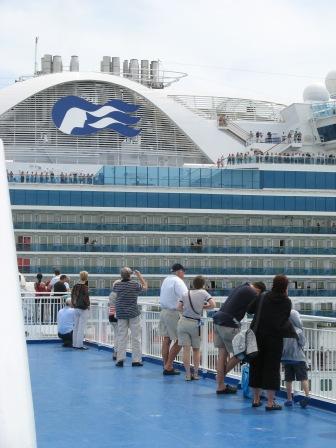I have taken some cruises, let me state for the record. What follows is not a screed against cruises. Sometimes a screed isn’t even necessary.
As I have mentioned elsewhere, cruises are one of Venice’s main sources of income — not from the paltry trinkets that the passengers may buy as they wander the streets on shore leave, or from the soggy sandwiches or slices of cold pizza they may eat while sitting on a bridge, but from the tax levied on each passenger of about 100 euros each.
Today I only want to share with you the sheer — there must be a word — sheerness of the sight which greeted me as I reached the end of via Garibaldi this morning.
We knew yesterday evening that a cruise ship, as occasionally happens, was destined to be moored at the Riva dei Sette Martiri, because the wire fence that serves as a minimal sort of barrier had already been set up.
What I hadn’t really noticed last night was that the fence stretched the entire length of the Riva, which I now know is about 970 feet, give or take. Because the ship that is tied up there is officially 965 feet long and, by the look of it, about three miles high.
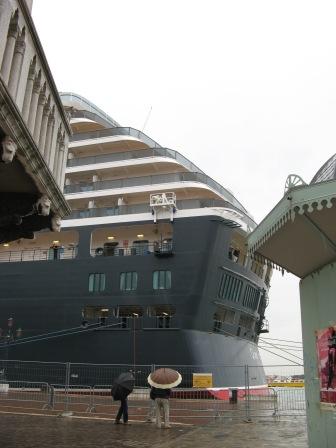
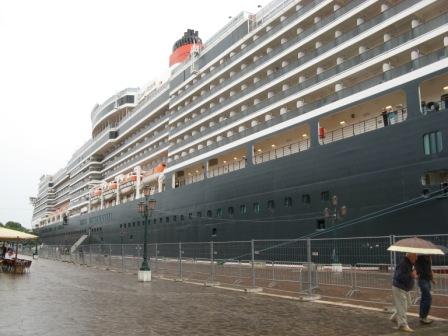
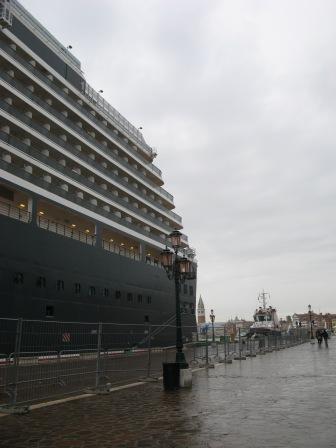
Cruise ships come in and out of Venice virtually every day from April to October (plus a little bit on each end). On weekends it’s the March of the Pachyderms when as many as seven arrive in the morning and depart that evening, a turnaround system that would dazzle the Ferrari pit crew.
My impression, standing by this behemoth, was that this is the largest thing afloat that isn’t an iceberg. But the facts are otherwise (fancy way of saying I was wrong). In fact, I must be really easy to impress, considering how far down the list (34th) of behemoths she ranks.
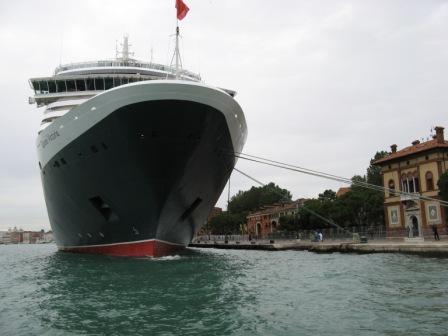
The “Queen Victoria”‘s stats are: 965 feet long and carries 2,000 passengers.
The “Oasis of the Seas,” which has yet to grace Venice with her presence, God forbid, measures 1,181 feet and carries 5,400 passengers.
I’ve seen plenty of ships which are essentially the same size as the Queen Vic: the “Norwegian Gem” (965 feet), MSC “Musica” (964), “Costa Serena” (952), and the “Ruby Princess” (951). So I really shouldn’t have been so stunned — it’s just that the others moor in the maritime zone and I only see them underway at some moderate distance from the shore. Walking past the “Queen Victoria” is like walking past the Great Wall of China.
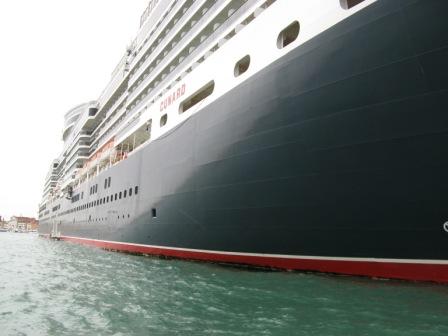
And then I got to thinking. It carries 2,000 passengers and about 1,000 crew (I like that ratio, by the way). And it’s got so much square footage that I don’t want to stop to figure it out, amusing as that might be.
All I was thinking is this: The proportions are essentially ludicrous, in the same way that it’s ludicrous that a vehicle has been invented (a car) which weighs 2,000 pounds in order to carry me, which weighs 125. Now we have this leviathan of the seas carrying a mere 2,000 passengers, which probably means that each one rates 4,500 square feet all his or her own.
Or look at it this way: All 2,000 of those paying guests, none of whom is any larger than the crumblike humans in the photographs, are the only thing keeping this mutant mammoth alive. If it weren’t for the assortment of tiny plantigrade mammals I saw descending the gangway in the rain, this colossus would just starve and die.
The idea that something so big could be so vulnerable is nothing new. Other behemoths come to mind, such as the Temple of the Jaguar Priest at Tikal, or the Hill Complex of Great Zimbabwe. But we keep building them all the same. Maybe it makes us feel slightly less crumblike.
